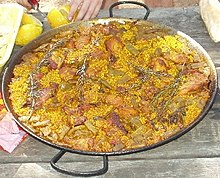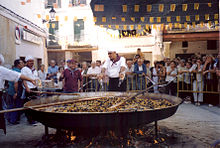Paella
This article includes a list of references, related reading, or external links, but its sources remain unclear because it lacks inline citations. (November 2007) |




Paella (IPA: [pa'eʎa]) is a typical valencian rice dish from Spain. The name paella is the word for "frying pan" in Valencian (from Latin patella).
Paella is usually garnished with vegetables and meat or seafood. The three main ingredients are rice (usually Calasparra[1][2] or Bomba[2] varieties.), saffron, and olive oil.
Legends about its origin
- There is an old story[citation needed] of how the Moorish kings' servants created rice dishes by mixing the leftovers from royal banquets in large pots to take home. In the Arab countries, it is often wrongly believed[citation needed] that the word paella originates from the Arabic word baqiyah, meaning leftovers.
- The story about the word paella deriving from para ella (for her) is wrong[citation needed] too, even though it is said[citation needed] that most paellas are made by men cooking once a week for their wives.
- It has been noted[citation needed] the similarity in name and method of cooking with the Pilaf dish. The word paella has some resemblance to that of other rice dishes made from Greece to Iran: Pilaf, Pilau, Polo. All are prepared in similarly shaped cookware.
- The origin of the name paella is in the Catalan word for frying pan. This word in turn derives from Latin patella and is akin to French poêle, Italian padella, Old Spanish padilla and New Mexican Spanish puela.
Basic cooking method
For recipes, see Wikibooks:Cookbook:Paella.
Paella is cooked in a paella pan, which is a large, shallow, flat pan. An important part of the flavor comes from the addition of saffron and the sofrito, or the combination of tomatoes, and garlic (and sometimes peppers). First the meat, and then the vegetables are stir fried in olive oil; subsequently water is added and brought to a boil, and left boiling for half an hour or so. (This, however, is not the sole method utilized in the preparation. Many chefs add the water, allow it to come to the boil and at that moment add the rice.) Later, after checking the obtained broth flavour and adding salt if required, the rice is added. The rice in Valencian paella is never stir-fried in oil, as pilau, though the paella made further southwest of Valencia often is. Once the rice is nearly done, the paella is removed from the heat and left to absorb the remaining water. Traditional paella has a crispy, caramelized, toasted bottom (called socarrat in Valencian) that is considered a delicacy. To achieve a socarrat, one either needs to time the evaporation of the water properly with the completion of the rice being cooked or turn up the heat to high and listen to the bottom of the rice toast. Once the aroma of toasted rice comes from the pan, but before the rice burns, the heat is removed once again. The paella is ready to be served after having cooled for several minutes.
Related paella traditions
It has become a custom[citation needed] for mass gatherings in the Valencian Community (festivals, political campaigns, protests, etc.) to prepare an enormous paella, sometimes to win a mention in the Guinness Book of Records. Ad hoc wide-diameter pans are commissioned for these cases.
Related dishes
Largest paella
The largest paella measured 20m (65ft 7in) in diameter and was made by Juan Carlos Galbis and a team of helpers in Valencia, Spain on 8 March 1992. It was eaten by 100,000 people.
Paella and its variations are typical picnic dishes for the Spanish spring and summer. The dish is also typically consumed during the Falles in Valencia.
Paella contests
In the world of competitive cooking, Paellas are seldom used[citation needed], save in Spain in the giant Paella King contest. This is an annual competition held in a different town in Galicia, Spain every year. Whoever makes the best Paella is the "Paella King" for the year until the next competition.
In Villamañán during the festival Fiestas de la Zarza, Concurso de Paellas or the Paella Contest, in which all peñas cook paellas and compete for the prize of the best paella of them all[citation needed].
See also
References
- ^ Delia Online - Rice(accessed 12/04/2008)
- ^ a b Tienda.com - Paella Rice(accessed 12/04/2008)
